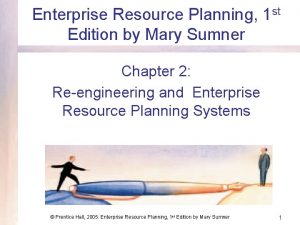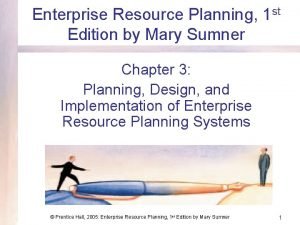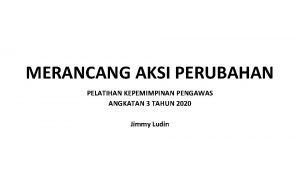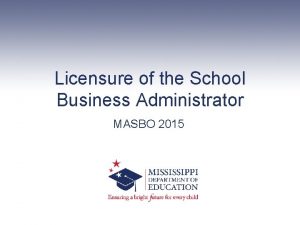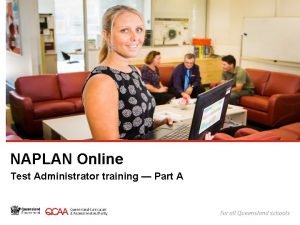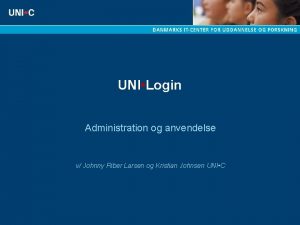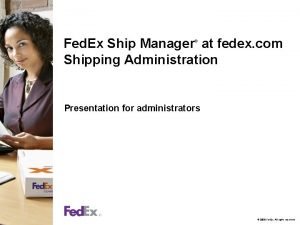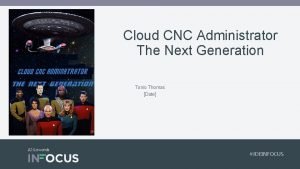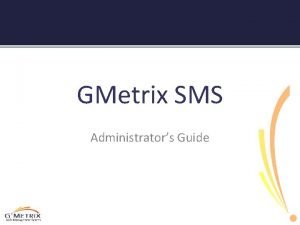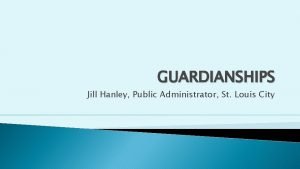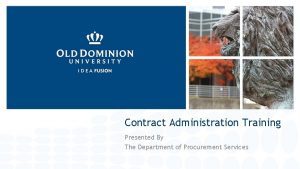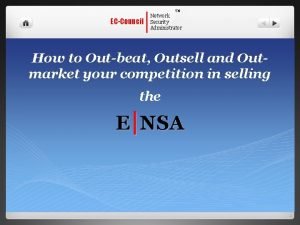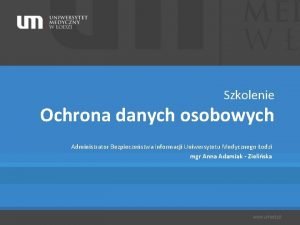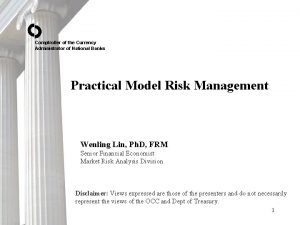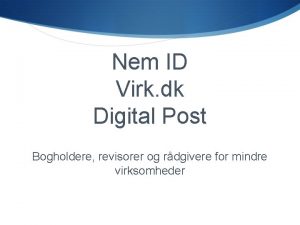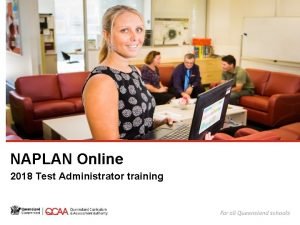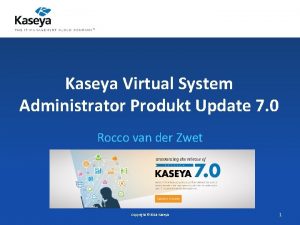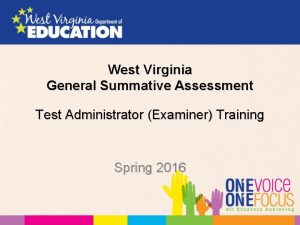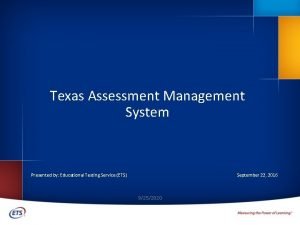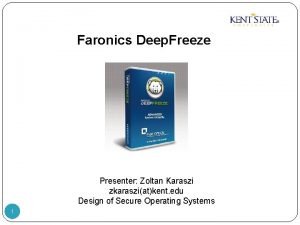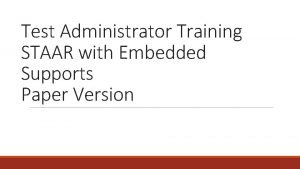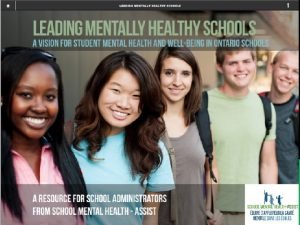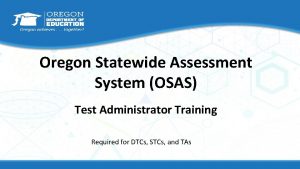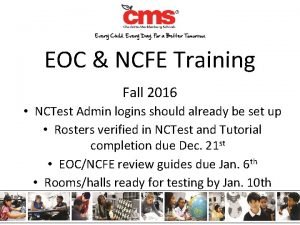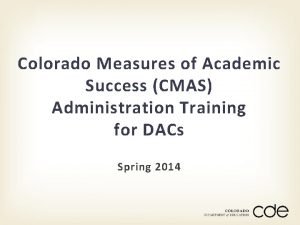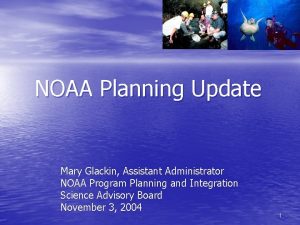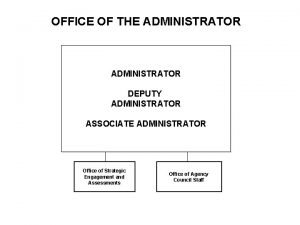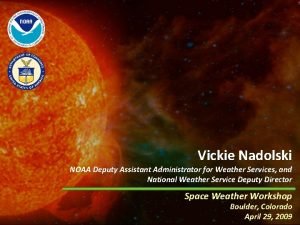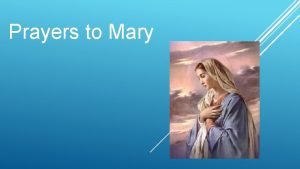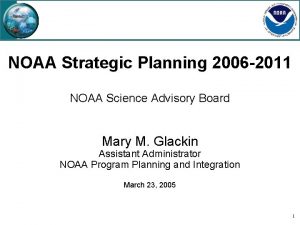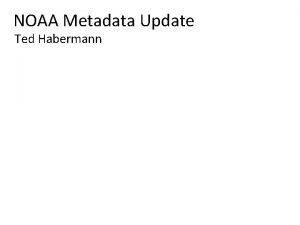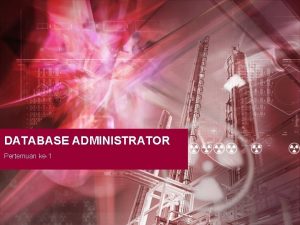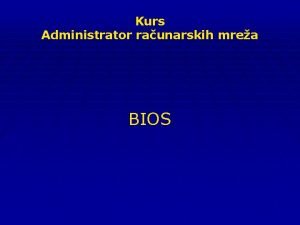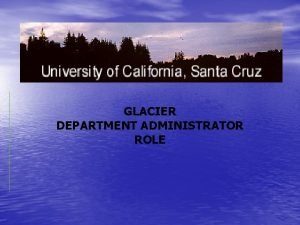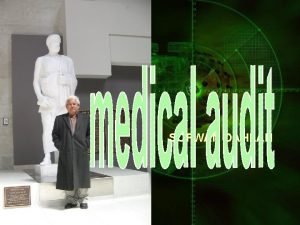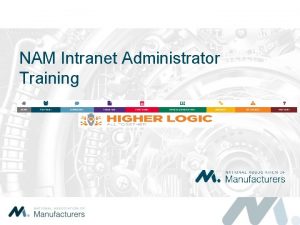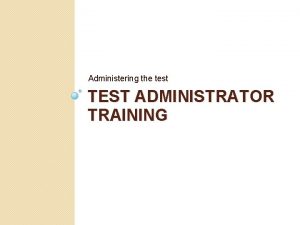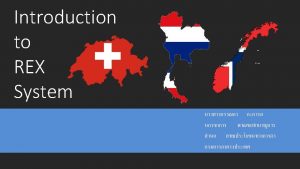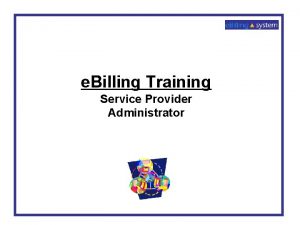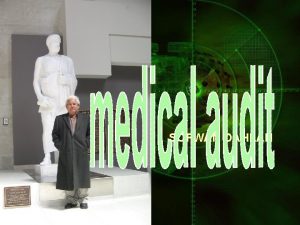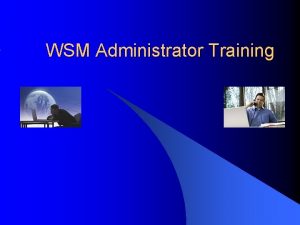NOAA Planning Update Mary Glackin Assistant Administrator NOAA




























- Slides: 28

NOAA Planning Update Mary Glackin, Assistant Administrator NOAA Program Planning and Integration Science Advisory Board November 3, 2004 1

Outline • NOAA Strategic Plan for 2005 -2010 • NOAA Program Structure – linking Programs to the • • Strategic Plan Annual Guidance Memorandum Associated Planning Documents NOAA’s Strategic Organization and PPBES FY 08 Planning Process – A Look Ahead 2

NOAA Strategic Plan for 2005 – 2010 NOAA Envisions… An informed society that uses a comprehensive understanding of the role of the oceans, coasts, and atmosphere in the global ecosystem to make the best social and economic decisions 3

To Meet the Challenges… NOAA’s Strategic Plan for 2005 – 2010 Mission Vision An informed society that uses a comprehensive understanding of the role of the oceans, coasts, and atmosphere to make the best social and economic decisions Drivers To understand predict changes in the Earth’s environment and conserve and manage coastal and marine resources to meet our Nation's economic, social, and environmental needs Strategic Goals Ecosystems Protect, restore & manage the use of coastal and ocean resources through an ecosystems approach to management Climate Understand climate variability and change to enhance society’s ability to plan and respond Weather and Water Serve society’s needs for weather and water information Commerce and Transportation Support the Nation’s commerce with info for safe, efficient & environmentally sound transportation Supporting NOAA’s Mission Provide Critical Support for NOAA’s Mission Cross-Cutting Priorities Developing, Valuing, and Sustaining a World -Class Workforce Ensuring Sound, State -of-the-Art Research Promoting Environmental Literacy Leading International Activities Integrating Global Environmental Observation and Data Management 4

We’ve Set These Five NOAA Goals: • Protect, restore, and manage the use of coastal and ocean resources through an ecosystem approach to management • Understand climate variability and change to enhance society’s ability to plan and respond • Serve society’s needs for weather and water information • Support the nation’s commerce with information for safe, efficient, and environmentally sound transportation • Provide critical support for NOAA’s mission 5

6

Protect, Restore, and Manage the Use of Coastal and Ocean Resources through an Ecosystem Approach to Management OUTCOMES STRATEGIES Programs 1. Engage and collaborate with our partners to achieve regional objectives 2. Manage uses of ecosystems by applying scientifically sound observations, assessments, and research findings 3. Improve resource management by advancing our understanding of ecosystems through better simulation and predictive models. 4. Develop coordinated regional and national outreach and education efforts 5. Engage in technological and scientific exchange with our domestic and international partners Habitat Corals Ecosystem Observations Coastal and Marine Resources Ecosystem Research 1. Healthy and productive coastal and marine ecosystems that benefit society 2. A well informed public That acts as a steward of coastal and marine ecosystems Protected Species Aquaculture Fisheries Management Enforcement 7

Understand Climate Variability and Change to Enhance Society’s Ability to Plan and Respond OUTCOMES STRATEGIES 1. 2. 3. 4. 5. 6. 7. Programs 8. Improve the quality and quantity of climate observations, analyses, interpretation, and archiving Improve the quantification and understanding of the forces bringing about climate change Advance sub-seasonal to inter-annual climate predictions and climate change projections Develop the ability to predict the consequences of climate change on ecosystems Develop and contribute to routine state-of-the-science assessments of the climate system Work with customers in order to deliver climate services and information products Coordinate among NOAA Line Offices the transition from investigator-driven research projects to operational facilities, capabilities, and products Support educational efforts to create a more climateliterate public Observations & Analysis Climate Forcing Predictions & Projections 1. A scientifically and observationally based understanding of the global climate system, with quantified uncertainties sufficient for making informed and reasoned decisions 2. A climate-literate public that recognizes the importance of the scientific basis for responding to climate change and variability 3. Enhanced public and private sector use of climate information, including predictions and projections, in planning and decision-making Climate & Ecosystems Regional Decision Support 8

Serve Society’s Needs for Weather and Water Information OUTCOMES STRATEGIES 1. 2. 3. Improve the reliability, lead-time, and effectiveness of weather and water information and services that predict changes in environmental conditions 1. Reduced injury, loss of life, and economic damage Integrate an information enterprise that incorporates all stages from research to delivery, seeks better coordination of employee skills and training, and engages customers. Develop and infuse research results and new technologies more efficiently Work with private industry, universities, and national and international agencies to create and leverage partnerships 5. Build a broad-based and coordinated education and outreach program 6. Employ scientific and emerging technological capabilities to advance decision support services and educate stakeholders Programs 4. Local Forecasts & Warnings Hydrology Coasts, Estuaries, Ocean 3. Routine use of NOAA products and services in making social and policy decisions 4. Increased customer satisfaction with weather and water information and services 5. A public who understands the impact of weather and water on their lives, and can make informed decisions and take appropriate action Environmental Modeling Air Quality 2. Social and economic benefits from improvements and applications of information and services Space Weather Science, Tech. , & Infusion 9

Support the Nation’s Commerce with Information for Safe, Efficient, and Environmentally Sound Transportation OUTCOMES STRATEGIES 1. Expand enhance advanced technology monitoring and observing systems to provide accurate, up-to-date information 1. Safe, secure, and seamless movement of goods and people in the U. S. transportation system 2. Develop and apply new technologies, methods, and models to increase the capabilities, efficiencies, and accuracy of transportation-related products and services 3. Develop and implement sophisticated assessment and prediction techniques, products, and services to support decisions 2. Environmentally sound development and use of the U. S. transportation system Programs 4. Build public understanding of the science and technology involved and the role of the environment in commerce and transportation through outreach, education, and industry collaboration Surface Weather Marine Transp. Systems Aviation Weather NOAA Emergency Response Geodesy Commercial & Remote Sensing Licensing 10

Supporting NOAA’s Mission STRATEGIES OUTCOMES 1. A safe operating environment with efficient and effective financial, administrative, and support services 1. Provide timely and effective acquisition and delivery of satellite-derived information 2. Use effective and efficient approaches to meet NOAA requirements for ship and aircraft support 3. Formulate and maintain policies, procedures, plans, and processes 4. Coordinate NOAA’s homeland security-related plans, programs, and policies 3. NOAA Homeland Securityrelated capabilities that are fully integrated 5. Plan for, construct, and maintain facilities 6. Lead agency-wide efforts in education and outreach, public affairs, legislative affairs, international affairs, and legal affairs 7. Develop and maintain an Information Technology Enterprise Programs 8. Employ a planning, programming, budgeting, and execution system to enhance NOAA’s capabilities … Satellites Fleet Services 2. Ship, aircraft, and satellite programs that ensure continuous observation Leadership 4. A sustainable and strategic facilities master planning process with a 5 -10 year planning horizon 5. Secure, reliable, and robust information flow within NOAA and out to the public Mission Support 11

FY 07 Annual Guidance Memorandum • The AGM – – – Guides the transformation of our plans into programs Provides the means for setting fiscal priorities Assists the decision-making as to where our resources are best spent to achieve our goals – Addresses significant capability gaps • The AGM does not – – Provide solutions to “fix” gaps Provide assurance that critical gaps will be met Provide specific programming direction Provide fiscal guidance 12

AGM Future Directions Meeting our Priorities Through Effective Partnerships • Taking the Pulse of the Planet – Integrate Global • • Observations Advance NOAA’s Modeling Capability Provide Leadership for Our Oceans Increase Climate Information, Services, and Products Provide Critical Information for Water Resources Support the US Transportation Systems Enhance Environmental Literacy Deliver Effective, Efficient Decision-Support Information 13 Link to More Detail

AGM Enablers Meeting our Priorities Through Effective Partnerships • Enhance Skills and Capabilities of NOAA’s • • Workforce Improve Administrative Programs Maintain and Provide Necessary Platforms Improve Critical Infrastructure and Services Advance the Use of Technology 14

Strategic Plans DOC Strategic Plan Goal 3: Observe, protect, and manage the Earth’s resources to promote environmental stewardship NOAA Strategic Plan Goals and Strategies Line & Staff Office Strategic Plans Cross-cut priorities Council Strategic Plans • Human Capital Council • Observing Systems Council • Research Council • Education Council • International Affairs Council 15

NOAA’s Strategic Organization Co un cil s NOAA Headquarters Po Pr lic oc y & ed ur e Research Weather Service Ocean Service Satellite & Information Service Fisheries Marine & Aviation Operations Program Planning & Integration Staff Offices Ecosystems Outcomes Climate Weather and Water Commerce & Transportation Supporting NOAA’s Mission Products & Services 16

PPBES Functions Planning Adjust goal & strategies as necessary Assess baseline compared to goals Programming Determine optimal use of resources Budgeting Request resources and adjust plan as necessary Execution Closeout Execute, assess, adjust, and report Annual Review Products Set priorities NOAA Strategic Plan Annual Guidance Memorandum NOAA Budget NOAA Program Plan DOC Budget President’s Budget Appropriation 2. 5 years prior to Execution Year Program Annual Operating Plans (AOPs) Audit Line & Staff Office AOPs Program reports Employee Performance Plans Business report Employee appraisals 17

FY 08 Planning – A Look Ahead • Planning Phase to run March – August 2005 • Priorities for Planning: – More effective coordination with external partners – More time for external review of AGM 18

Summary • NOAA Planning Phase effectively linking through to Execution Phase • Draft Line Office Strategic Plans out for review until November 30 (http: //www. spo. noaa. gov/losps. htm) • FY 08 planning goal – target more partner participation 19

Backup slides

FY 07 Annual Guidance Memorandum: Future Directions Taking the pulse of the planet – Integrate Global Observations • • • • Provide leadership to develop and implement national interagency systems Develop IOOS as a major component of the US contribution to GEOSS Focus on connecting and strengthening existing observations systems Ensure continuity of observations Develop new techniques and measurements Use analysis capabilities to ensure collected data are optimal Employ consistent data management strategy that handle large data volumes expected from GEOSS Move proven systems into operations Direct resources and research toward exploring new technologies Form ecosystem component of GEOSS Diversify observations to make efficient use of vessels and other platforms Leverage platforms for multi-purpose observations Implement an observing and data management system that ensures data flow to our customers 21

FY 07 Annual Guidance Memorandum: Future Directions Advance NOAA’s Modeling Capability • Develop a world-class environmental modeling capability with required high-performance computing infrastructure • Support research to operations • Develop and apply advance data assimilation techniques • Adopt a modeling framework that supports estuaries, oceans, weather, and climate change and extends to ecosystems as the science matures • Support increasing data inputs from GEOSS • Enhance model resolution 22

FY 07 Annual Guidance Memorandum: Future Directions Provide Leadership for the Oceans • Develop and implement an ecosystems approach to management • Strengthen partnerships at local and regional levels • Improve existing regional coordination across NOAA and with other agencies • Invest in research and development to understand ecosystem function • Continue to meet our mandates to rebuild and sustain fishery stocks • Continue lead role in monitoring, managing, and conservation of known population and protected areas • Strengthen recovery planning for protected species • Conduct ecological and socioeconomic risk-benefit assessments • Advance decision-support tools • Perform a systems analysis to guide our efforts • Create environmental standards and evaluation protocols for aquaculture 23

FY 07 Annual Guidance Memorandum: Future Directions Increase Climate Information, Services, and Products • Support Climate Change Science Program (CCSP) synthesis product generation • Support the Intergovernmental Panel on Climate Change (IPCC) assessments • Provide long-term and process oriented research to support CCSP and IPCC • Build on established climate prediction capabilities by focusing on specific regional and local services • Deliver climate-relevant information, service, and products on long- and short -term scales • Promote the transition of research findings to products and services • Provide an early warning capability for climate extremes • Develop test-bed concept to support the transition of research into operations • Actively Participate in the International Polar Year 24

FY 07 Annual Guidance Memorandum: Future Directions Provide Critical Information for Water Resources • Deliver observations and forecast products on the quality of water in the coastal zone • Provide leadership in order to develop a comprehensive framework for the delivery of water resource information • Develop and implement a comprehensive framework for water resource information and prediction delivery • Improve short-term stream flow and long-term water supply predictions 25

FY 07 Annual Guidance Memorandum: Future Directions Support the US Transportation Systems • Identify valid user needs that cannot be met with existing information • Increase and improve products and services that support transportation systems • Work with partners to conduct research and development in weather and geo-positioning • Improve the translation of research into operational value 26

FY 07 Annual Guidance Memorandum: Future Directions Enhance Environmental Literacy • Develop sustainable education activities • Enhance partnerships with informal education entities • Increase participation by underrepresented groups • Evaluate existing NOAA education materials • Expand teacher professional development efforts • Increase learning opportunities for students • Improve collaboration researchers • Increase fellowship and internship opportunities • Increase coordination with other federal agencies 27

FY 07 Annual Guidance Memorandum: Future Directions Deliver Effective, Efficient Decision-Support Information • Maximize the contribution of science and technology • Investigate, develop, and expand use of new technologies • Integrate information across disciplines and organizational elements as driven by customer needs • Deliver effective products and services to support decision makers • Review operational concepts and identify opportunities for efficiencies Back to AGM 28
 Shadow paging recovery technique
Shadow paging recovery technique Mary wollstonecraft mary a fiction
Mary wollstonecraft mary a fiction Enterprise resource planning mary sumner
Enterprise resource planning mary sumner Enterprise resource planning mary sumner
Enterprise resource planning mary sumner Judul rancangan aksi perubahan pkp
Judul rancangan aksi perubahan pkp School business administrator licensing
School business administrator licensing Http://www.assessform.edu.au
Http://www.assessform.edu.au Uni login administrator
Uni login administrator Fedex online ship manager
Fedex online ship manager The next generation
The next generation Free gmetrix access codes
Free gmetrix access codes Jill hanley
Jill hanley Contract administrator training
Contract administrator training Ec-council network security administrator
Ec-council network security administrator Administrator bezpieczeństwa informacji szkolenie
Administrator bezpieczeństwa informacji szkolenie Comptroller of the currency administrator of national banks
Comptroller of the currency administrator of national banks Nemrefusion virk
Nemrefusion virk Www.assessform.edu.au login
Www.assessform.edu.au login Kaseya virtual system administrator
Kaseya virtual system administrator General summative assessment wv
General summative assessment wv Www.texas assessment.com
Www.texas assessment.com Unfreezer for deep freeze 7
Unfreezer for deep freeze 7 O*net ability profiler
O*net ability profiler Staar
Staar President help wanted ad
President help wanted ad Role of school administrator
Role of school administrator Osas sample test
Osas sample test Nctestadmin
Nctestadmin Cmas test nav
Cmas test nav


